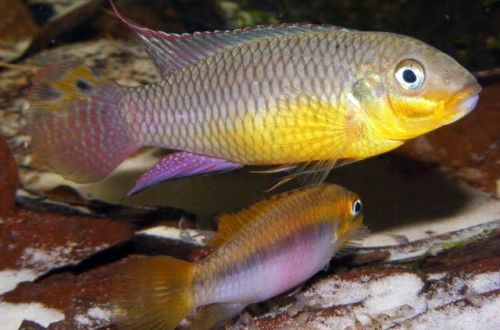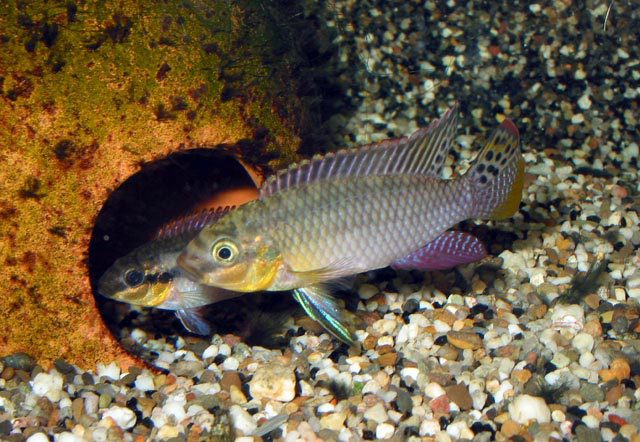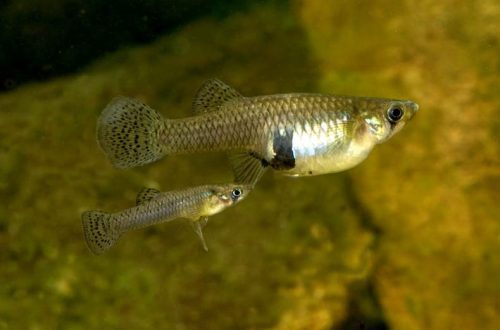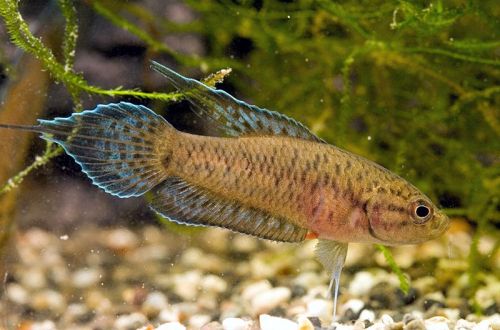
Kribensis teniatus
Cribensis teniatus, scientific name Pelvicachromis taeniatus, belongs to the Cichlidae family. A beautiful unpretentious fish, goes well with many other freshwater species. Its maintenance and breeding does not cause big problems, so it can be recommended to beginner aquarists.

Contents
Habitat
Occurs from the equatorial part of the African continent from the territory of Nigeria and Cameroon. It is found in rivers and streams flowing in the shade of tropical forests. The natural habitat is slow flowing with rich aquatic vegetation. The bottom of reservoirs, as a rule, is littered with numerous snags, foliage, etc.
Brief information:
- The volume of the aquarium – from 60 liters.
- Temperature – 22-26°C
- Value pH — 5.0–7.0
- Water hardness – soft (5-12 dGH)
- Substrate type – sandy or fine gravel
- Lighting – subdued
- Brackish water – no
- Water movement is weak
- The size of the fish is 6–8 cm.
- Meals – any
- Temperament – peaceful
- Keeping both alone and in a group with one male and several females
Description

Adult males reach a length of about 8 cm, females are somewhat smaller – no more than 6 cm. In addition to size, males are distinguished by an elongated dorsal and anal fin. The coloration is gray with a yellow belly and pinkish fins. Females have a similar coloration, and during the spawning period, their abdomen acquires a bright scarlet color.
Food
Fish undemanding to the diet. Will accept most feeds. If breeding is planned, then frozen or live foods, such as bloodworms and brine shrimp, should be the basis of the diet.
Maintenance and care, arrangement of the aquarium
The optimal size of the aquarium for one pair of fish starts from 60 liters. In the design of a sandy or fine gravel substrate, live or artificial plants, as well as polynomial shelters. As the latter, not only snags can act, but also various decorative objects, or ordinary ceramic pots turned over on their side. They will act as caves. Plants form dense clusters and are placed in certain areas to leave open areas for swimming. Fish prefer subdued lighting, so give preference to shade-loving plant varieties.
Successful keeping depends on maintaining suitable water conditions and regular maintenance of the aquarium. The hydrochemical composition of water has slightly acidic pH values with low carbonate hardness. Maintaining the high quality of water will be facilitated by its weekly renewal by 15-20% of the volume, timely removal of organic waste and installation of a productive filtration system. In addition, this will avoid exceeding the concentrations of hazardous substances (products of the nitrogen cycle) in the aquarium.
Behavior and Compatibility
Calm peaceful fish, compatible with other non-aggressive fish of comparable size. Accordingly, the introduction of large, overly energetic and especially predatory fish should be avoided. With the onset of the mating season, the behavior of the male changes. He chooses a site at the bottom of the aquarium – the place of future masonry, and begins to protect it from potential rivals. However, for other fish, this does not pose a great danger.
It is recommended to keep in a pair or group, where there will be several females per male. Moreover, the fish should grow together from a young age. It is noted that newly planted relatives may be attacked. Thus, it is recommended to purchase fish from the same breeder who live in the same tank.
Breeding / breeding
Under favorable conditions, breeding Kribensis teniatus is quite simple if a well-established community of fish is available. As noted above, introducing new adults, such as male and female from different tanks, is fraught with problems.
For spawning, the male chooses a site with a shelter in the form of a cave, where the female lays eggs. She remains next to the masonry until the fry appear. The male at this time remains outside for protection. The incubation period lasts about 2-3 days. After another week, the fry begin to swim freely and leave the shelter. Parents continue to protect their offspring for some time.
Diseases
Kribensis is hardy, the main cause of the disease, as a rule, is contact with other sick fish or a significant deterioration in living conditions and food quality. Read more about symptoms and treatments in the Aquarium Fish Diseases section.





